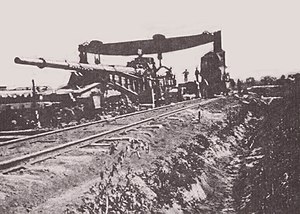Paris Gun
| Paris Gun | |
|---|---|

The German Paris Gun, also known as William's Gun, was the largest artillery gun of World War I. In 1918 the Paris Gun was able to shell Paris from 120 kilometres (75 mi) away.
|
|
| Type | Super heavy field cannon |
| Place of origin | German Empire |
| Service history | |
| Used by | German Empire |
| Wars | World War I |
| Production history | |
| Designer | Fritz Rausenberger |
| Manufacturer | Krupp |
| Specifications | |
| Weight | 256 tons |
| Length | 34 m (111 ft 7 in) |
|
|
|
| Caliber | 211 mm, later rebored to 238 mm |
| Breech | horizontal sliding-block |
| Elevation | 55 degrees |
| Muzzle velocity | 1,640 m/s (5,400 ft/s) |
| Effective firing range | 130 km (81 mi) |
The Paris Gun (German: Paris-Geschütz / Pariser Kanone) was the name given to a type of German long-range siege gun, several of which were used to bombard Paris during World War I. They were in service from March to August 1918. When the guns were first employed, Parisians believed they had been bombed by a high-altitude Zeppelin, as the sound of neither an aeroplane nor a gun could be heard. They were the largest pieces of artillery used during the war by barrel length, and are considered to be superguns. The Paris Guns hold an important place in the history of astronautics, as their shells were the first human-made objects to reach the stratosphere.
Also called the "Kaiser Wilhelm Geschütz" ("Emperor William Gun"), they were often confused with Big Bertha, the German howitzer used against the Liège forts in 1914; indeed, the French called them by this name, as well. They were also confused with the smaller "Langer Max" (Long Max) cannon, from which they were derived; although the famous Krupp-family artillery makers produced all these guns, the resemblance ended there.
As military weapons, the Paris Guns were not a great success: the payload was small, the barrel required frequent replacement, and the guns' accuracy was only good enough for city-sized targets. The German objective was to build a psychological weapon to attack the morale of the Parisians, not to destroy the city itself.
The Paris Gun was a weapon like no other, but its capabilities are not known with full certainty. This is due to the weapon's apparent total destruction by the Germans in the face of the Allied offensive. Figures stated for the weapon's size, range, and performance varied widely depending on the source—not even the number of shells fired is certain. With the discovery (in the 1980s) and publication (in the Bull and Murphy book) of a long note on the gun written shortly before his death in 1926 by Dr. Fritz Rausenberger, who was in charge of its development at Krupp, the details of its design and capabilities were considerably clarified.
...
Wikipedia
